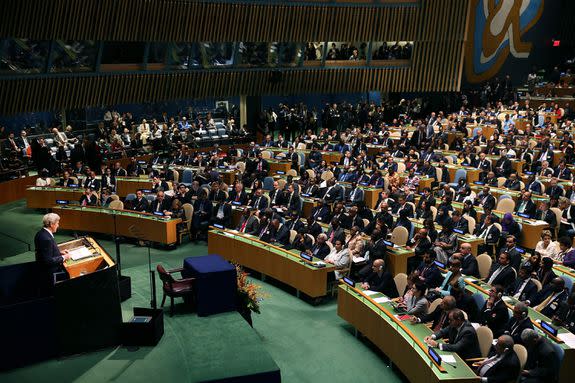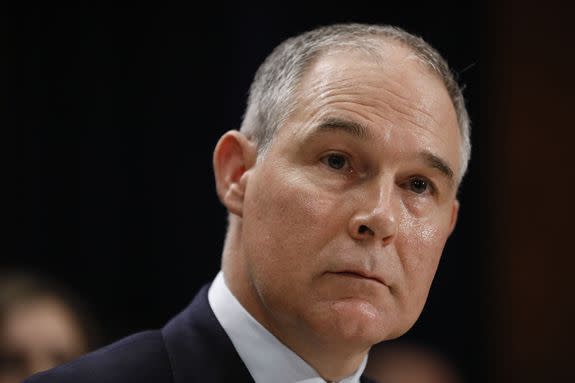Trump's order will unravel America's best defense against climate change

Environmentalists, climate advocates and many world leaders have feared this moment ever since President Donald Trump took office. On Tuesday, with the anticipated signing of an Executive Order, the great climate policy dismantling is slated to begin.
This will kick off the unwinding of the Obama administration's climate efforts, including the landmark set of regulations known as the Clean Power Plan. This program, administered by the Environmental Protection Agency (EPA), is America's most comprehensive effort to slash carbon dioxide emissions from power plants and steer the economy away from fossil fuels.
Trump, it seems, is determined to turn the wheel back toward those dirty fuels, no matter the environmental costs.
SEE ALSO: EPA chief calls historic climate treaty a 'bad deal' because this is our life now
The regulations require power plants to reduce total carbon emissions by 32 percent by 2030, compared to 2005 levels.
Despite its flaws, the Clean Power Plan is still the country's best defense against human-driven global warming, energy experts say.
Absent the policy, U.S. utilities will move far more slowly to curb their appetite for coal and natural gas — even as the rest of the world adopts more renewable energy. The plan is also essential to the U.S. meeting its targets laid out in the 2015 Paris Climate Agreement. Without it, America's word will be less credible on the international stage.

Image: spencer platt/Getty Images
"It's definitely a little depressing," said Noah Kaufman, a climate economist at the World Resources Institute, said of the expected reversal in Washington.
"It's frustrating that the federal government doesn't seem to want to play a more productive role," he said.
Still, virtually no one expected the Clean Power Plan to escape the Trump administration unscathed.
Trump and many of his top officials, including EPA Administrator Scott Pruitt, have said they are uncertain or outright skeptical of the mainstream scientific consensus that the world is warming, and that human activity is primarily to blame.
Adding to environmentalists' gloom, Pruitt, who oversees the Clean Power Plan, is one of its most ardent critics.

Image: Aaron P. Bernstein/Getty Images
As Oklahoma's attorney general, Pruitt led a nationwide legal battle to dismantle the regulations. The rule, which was designed to go into effect in 2015, was stayed by the Supreme Court in February 2016 until those lawsuits are resolved.
"Imagine a rule that raises the cost of electricity, hurts the most poor among us, cuts domestic jobs and results in a dramatic re-shaping of the American electricity system," then-attorney general Pruitt wrote in a 2014 op-ed in The Hill.

Image: spencer platt/Getty Images
Some large utilities have endorsed the plan and filed legal briefs in its favor. Dominion Resources, a major consumer of coal, said the rule was "challenging but ultimately manageable" in a 2016 brief.
The Obama administration estimated the plan would cost states and utilities around $8.4 billion a year. By contrast, public health and climate benefits could add up to around $34 billion to $54 billion per year in 2030 by driving down toxic air pollution, reducing water contamination and lowering greenhouse gas emissions.
Environmental groups have also criticized the plan. But as they see it, the policy doesn't go far enough to drive the kind of dramatic emissions reductions and renewable energy development that the U.S. needs to meet its long-term climate targets.
Under the Paris Climate Agreement, the U.S. has pledged to reduce it greenhouse gas emissions by 26 to 28 percent by 2025, compared to 2005 levels.
"The fact is that even with the Clean Power Plan and all of President Obama's other final and proposed regulations, the U.S. was not on a clear pathway to meeting the Paris target," said Michael Burger, executive director of the Sabin Center for Climate Change Law at Columbia Law School.
Without the Clean Power Plan and other programs Trump is expected to target, the U.S. has even less of a shot to get there, he added.
Repealing the policy "would seem to make it even less likely that we will see the kind of economy-wide shift away from fossil-fueled power that we need," Burger said. "It stalls progress toward the ultimate goal of net-zero or even negative emissions."
Numerous scientific studies show that unless we reach net-zero or negative emissions by 2100, the world will sail past the threshold of dangerous human-caused climate change and stay there, causing prolonged droughts, damaging sea level rise and killer heatwaves, among other impacts.
Any delay in cutting emissions, even just for a four year presidential term, could have major climate change consequences given that the U.S. is the world's second-largest greenhouse gas emitter.
Climate experts are taking some solace in the fact that the U.S. is already making substantial progress on clean energy because of market forces.
In recent years, coal-fired electricity has become less popular as utilities shift to cheaper natural gas, promote energy efficiency and invest in increasingly affordable wind and solar power.

Image: George frey/Getty Images
Since 2010, more than 250 U.S. coal plants have retired or committed to retire, driving U.S. coal use down to its lowest level in history, the Sierra Club's Beyond Coal campaign announced earlier this month.
"That [clean energy] transition has continued since Trump's election, and we expect that it will continue in the coming years," said John Coequyt, climate policy director for the Sierra Club.
However, the Clean Power Plan still represents an important "backstop" to keep America from reversing to its earlier, more carbon-intensive energy system. "If it doesn't exist, emissions reductions will be diminished," Coequyt said.
The EPA regulations are also key to maintaining U.S. leadership on climate and clean energy issues. If America lags behind, China, India and other large economies are poised to take over the mantle, experts said.
China, for instance, said it will plow about $361 billion into clean energy projects by 2020 as part of its broader effort to shift away from fossil fuels. Meanwhile, the Trump administration has proposed gutting many important federal energy programs that have helped launch the nation's large-scale solar industry and supported companies including Tesla.
"China has done a total about-face on climate in the last five to six years, and it's not because China is a goody two-shoes. It's because China sees a strong economic interest in making this transition," said Paul Bodnar, who oversaw international climate issues at the National Security Council during the Obama administration's second term.
"It would be good if, instead of arguing about whether or not we want to engage on this issue, we're getting ready to out-compete China in that [clean energy] race," said Bodnar, now managing director of the Rocky Mountain Institute.
"It's kind of like arguing about whether the automobile or the horse-and-buggy is the future of transportation, while somebody else is focused on making automobiles," he said.
Mashable Science Editor Andrew Freedman contributed reporting.
